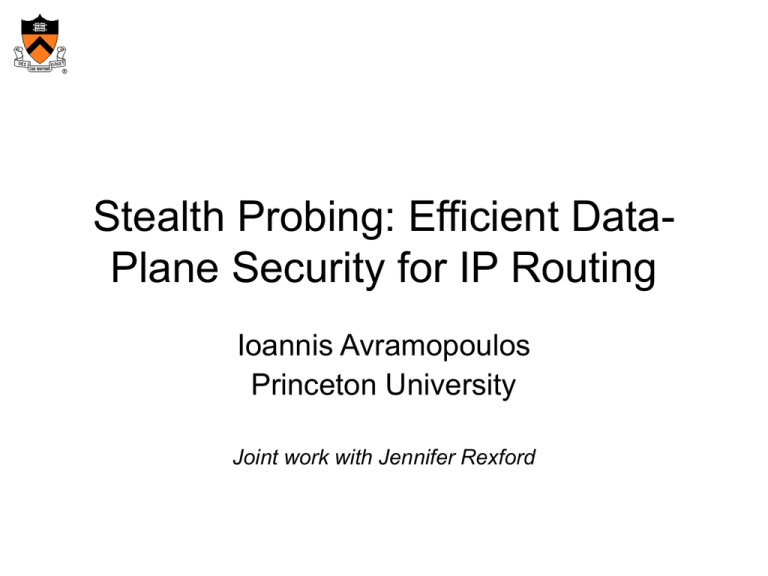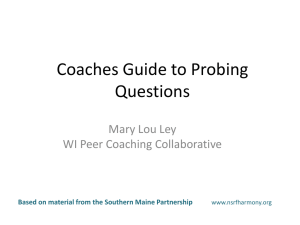Stealth Probing: Efficient Data- Plane Security for IP Routing Ioannis Avramopoulos Princeton University
advertisement

Stealth Probing: Efficient DataPlane Security for IP Routing Ioannis Avramopoulos Princeton University Joint work with Jennifer Rexford Hosts vis-à-vis Routers (Attacks against Availability) Routing Fabric (Routing Protocols) Routing Fabric (Data Forwarding) Attacks against the Routing Fabric (Breaking Perimeter Defense) AS1 Perimeters can be broken because of: AS: Autonomous System AS2 Disgruntled network operators Password guessing AS0 Exploits of the OS AS4 AS3 Attacks against the Routing Fabric (Routing Protocol Attacks and Defenses) • These attacks game the routing state by falsifying routing protocol messages • Falsifications come in two flavors: – Modification of en-route protocol messages – Collusion (or wormhole) attacks • Secure routing protocols protect from the modification of protocols messages – They do not protect from wormholes – They do not verify forwarding behavior Limitation of Secure Routing Protocols (Data-Plane Adversary) DATA DATA DATA Attacks against the Routing Fabric (Data-Plane Attacks) • Link layer disruption – Physical layer attacks – Medium access control layer attacks • Network layer disruption – – – – Packet loss Packet modification Packet delay Packet deflection • Transport layer disruption – Attacks against the congestion control mechanism Securing the Routing Fabric (Defending against Data-Plane Attacks) • Availability monitoring – Easy for the traffic source – Difficult from within the network • Fault localization – Beaconing and traceroute egregiously fail in adversarial networks – In adversarial networks, fault localization is difficult but necessary Overview • Introduction • Stealth Probing • Intradomain Deployment -- Byzantine Tomography • Interdomain Deployment -- Secure Route Control • Related Work • Conclusion Availability Monitoring (Problem Formulation) Naïve Solutions • Probing (e.g., ping) • Cumulative network-layer ACKs • Transport-layer ACKs ingress egress Stealth Probing (Approach) • • Prevent the adversary from preferentially treating probing traffic by making data and probing traffic indistinguishable Three steps 1. Create an encrypted tunnel and divert both data and probing traffic in the tunnel 2. Match the size of probing traffic with that of the data traffic 3. Obscure the timing of probes Stealth Probing (Approach---continued) ingress router egress router Stealth Probing (Approach---continued) ingress router egress router Stealth Probing (Primary Benefits) • Non-intrusive (low overhead) • Detects “delay attacks” (by measuring the round-trip-times of probing traffic) • Prevents selective low-rate attacks that target individual IP addresses (by hiding the source and destination IP addresses of data traffic) • Mitigates attacks that exploit TCP (by making the TCP mechanism “opaque”) Stealth Probing (Secondary Benefits) • Encryption protects unencrypted host-tohost communications • Fate-sharing between data traffic and probes is broadly useful in network troubleshooting • Tunnels are useful in traffic engineering Overview • Introduction • Stealth Probing • Intradomain Deployment -- Byzantine Tomography • Interdomain Deployment -- Secure Route Control • Related Work • Conclusion Basic idea • Fault localization without overburdening the data plane: – Terminal nodes monitor path availability – Terminal nodes disclose faulty paths to a designated network entity – This entity “triangulates” adversarial nodes and links from the collection of faulty paths Byzantine Tomography (Model) Byzantine Tomography Solves Minimum Hitting Set (Approach) Byzantine Tomography (Basic Property) • Output from Byzantine tomography is not always accurate • However, accuracy increases as fault knowledge expands • Therefore, the higher the adversary’s impact, the more likely it is that the adversary will be correctly detected Overview • Introduction • Stealth Probing • Intradomain Deployment -- Byzantine Tomography • Interdomain Deployment -- Secure Route Control • Related Work • Conclusion Secure Route Control AS B (Stub) Provider Provider Provider Provider Provider AS A (Stub) Secure Route Control (cont.) AS B (Stub) Provider Provider Provider Provider Provider AS A (Stub) Overview • Introduction • Stealth Probing • Intradomain Deployment -- Byzantine Tomography • Interdomain Deployment -- Secure Route Control • Related Work • Conclusion Related Work • Perlman proposed encryption to make data and control traffic indistinguishable – Perlman proposed encryption at network links – We extend this idea to network paths • Mizrak et al. proposed Fatih as a secure data-plane availability monitor – Fatih requires clock synchronization – Stealth probing does not rely on clock synchronization • Several researchers have proposed data-plane mechanisms for secure fault localization – Byzantine tomography is a management-plane technique Conclusion (1) • Resilience was a top priority in the design of the operational Internet but the threat model was naïve (vis-à-vis today’s attacks) • In future networks, we should expect to see – better perimeter defense and – in-depth defense • secure routing protocols • secure data forwarding • Stealth probing is a secure availability monitor that works by concealing probing traffic Conclusion (2) • We presented deployment scenarios of this monitor in – Intradomain routing and – Interdomain routing • Our ongoing work focuses on … : – Intradomain case: … improving the accuracy of Byzantine tomography – Interdomain case: … investigating the benefits of more flexible interdomain path selection schemes Thank you Questions






